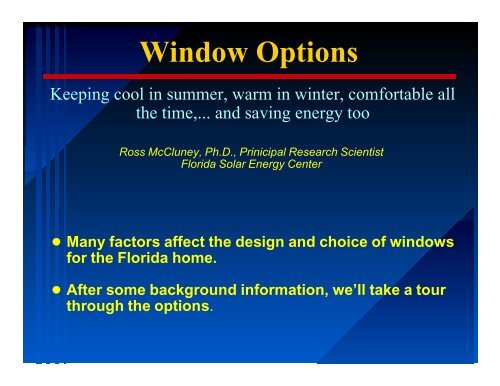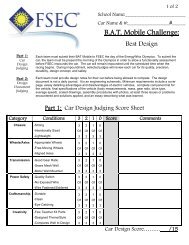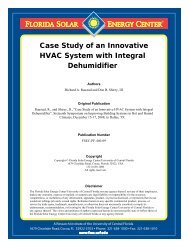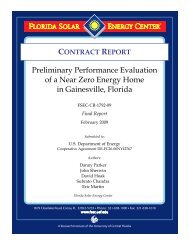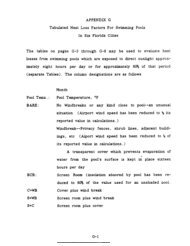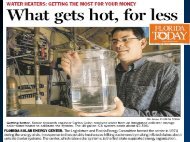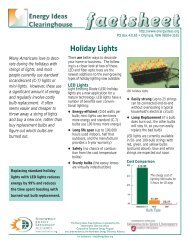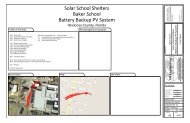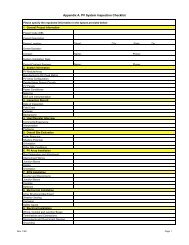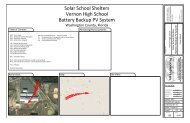Selecting Windows - Florida Solar Energy Center
Selecting Windows - Florida Solar Energy Center
Selecting Windows - Florida Solar Energy Center
You also want an ePaper? Increase the reach of your titles
YUMPU automatically turns print PDFs into web optimized ePapers that Google loves.
Window Options<br />
Keeping cool in summer, warm in winter, comfortable all<br />
the time,... and saving energy too<br />
Ross McCluney, Ph.D., Prinicipal Research Scientist<br />
<strong>Florida</strong> <strong>Solar</strong> <strong>Energy</strong> <strong>Center</strong><br />
! Many factors affect the design and choice of windows<br />
for the <strong>Florida</strong> home.<br />
! After some background information, we’ll take a tour<br />
through the options.
Are windows just<br />
“holes in the insulation?”<br />
Some are,but . . . “it ain’t necessarily so!”<br />
!Good windows can out-perform opaque insulated<br />
walls, energy-wise.<br />
!<strong>Windows</strong> provide much more than energy savings!<br />
!A building is there to provide comfort and protection<br />
from the elements, not just to save energy.<br />
!If energy can be saved too, that’s even better.<br />
!We’ll start with some basics<br />
!Then we’ll cover energy and economics<br />
!And finish with a summary of window option<br />
recommendations
Finding the Right Window<br />
P It is more than just choosing a pretty window.<br />
P We must also deal with the heat and the cold,<br />
as well as the glare and overheating of direct<br />
sunlight<br />
< The heat and cold: insulation and shading<br />
< The glare and overheating of direct sunlight:<br />
orientation and shading<br />
P Other issues<br />
< Choice of window frame and glazing<br />
< To insulate or not? < Acoustic isolation?<br />
< Impact resistance? < Utility concerns
Dealing with the Sun<br />
P The Good: Big windows provide a bright and open<br />
room with great views and good daylight<br />
illumination<br />
P The Bad: Overheating, fading of furnishings,<br />
blocked views<br />
P The Ugly: Killer glare from the sun, big energy<br />
bills, thermal discomfort<br />
P Three strategies for dealing with the sun<br />
< Know where the sun is<br />
< Shape and orient the building properly relative to the sun<br />
< Shade the windows and walls properly
Heat Transfer<br />
The three modes of heat transfer<br />
T hot Tcold<br />
Radiation Conduction Convection
Heat Flows Through <strong>Windows</strong><br />
Reflected solar<br />
radiation<br />
Glazing-absorbed<br />
solar radiant heat<br />
Outward flowing<br />
fraction of glazing<br />
absorbed radiation<br />
Absorbed solar radiation<br />
conducted through the frame<br />
Directly transmitted solar<br />
radiation through the glazings<br />
(includes both light & heat)<br />
Inward flowing fraction of<br />
glazing absorbed radiation
Heat Flows Through <strong>Windows</strong><br />
Reflected solar<br />
radiation<br />
Glazing-absorbed<br />
solar radiant heat<br />
Outward flowing<br />
fraction of glazing<br />
absorbed radiation<br />
Absorbed solar radiation<br />
conducted through the frame<br />
Directly transmitted solar<br />
radiation through the glazings<br />
(includes both light & heat)<br />
Inward flowing fraction of<br />
glazing absorbed radiation<br />
Heat conducted<br />
through the glass<br />
Heat conducted<br />
through the frame
Insulated windows reduce conduction,<br />
convection, and radiation<br />
Winter<br />
Summer<br />
Cold Warm<br />
Hot Cool<br />
Heat conducted<br />
through the<br />
glazing system<br />
Coatings reduce<br />
radiation transfer<br />
Insulating gas<br />
reduces conduction<br />
Proper spacing<br />
minimizes convection<br />
Insulation reduces<br />
heat conduction<br />
through the frame
Knowing Where the Sun is<br />
P Radiation from the sun is generally much stronger than<br />
that from the sky, except on hazy and partially overcast<br />
days<br />
P The sun moves through the sky in a known way each day<br />
P Radiation coming directly from the sun’s “disk” is called<br />
“direct beam radiation.”<br />
P Orienting the building and its windows is important to<br />
maximize the benefits and minimize the problems<br />
produced by direct beam solar radiation.<br />
P First we look at a generic drawing of the sun’s path<br />
through the sky on the summer and winter solstices<br />
P Then we consider how to orient a house properly relative<br />
to the sun’s positions in the sky
SUMMER WINTER<br />
Sun rises north of due east,<br />
sets north of due west,<br />
and is high in the sky at<br />
noon<br />
Shade:<br />
overhang for noon<br />
east to northeast morning<br />
west to northwest afternoon<br />
Sun rises south of due east,<br />
sets south of due west,<br />
and is low in the sky at<br />
noon<br />
Shade: southwest to west to<br />
protect west window on<br />
warm winter days
N<br />
Garage<br />
Orientation and shading<br />
Minimize east and<br />
west exposure<br />
Shade the facade<br />
Wide<br />
overhangs Fence<br />
Buffer East and<br />
West Exposures<br />
Closet<br />
Utility<br />
room
<strong>Solar</strong> Spectrum Fundamentals<br />
P The sun’s radiation covers a range of colors,<br />
and beyond.<br />
P This electromagnetic radiation has important<br />
features for the design and performance of<br />
windows in different climates.<br />
P We need to know a little more about the<br />
physics of solar radiation to fully understand<br />
the variety of window products now on the<br />
market.<br />
P We begin with the electromagnetic<br />
spectrum.
Breaking sunlight into<br />
its various colors<br />
Glass prism<br />
Invisible<br />
ultraviolet<br />
Blue<br />
400 nm<br />
Sir Isaac Newton<br />
1723<br />
Invisible<br />
infrared<br />
Red 700 nm<br />
Orange<br />
Yellow<br />
Green
Electromagnetic Spectrum<br />
Wave -<br />
length<br />
1pm<br />
1nm<br />
1:m<br />
1mm<br />
1m<br />
1km<br />
Cosmic<br />
rays<br />
Gamma<br />
rays<br />
X rays<br />
UV<br />
IR<br />
Radio<br />
Microwaves<br />
Visible<br />
spectrum<br />
UV<br />
400 nm<br />
450 nm<br />
500 nm<br />
550 nm<br />
600 nm<br />
650 nm<br />
700 nm<br />
750 nm<br />
IR<br />
320 nm<br />
<strong>Solar</strong><br />
spectrum<br />
3500 nm
Parts of the solar spectrum<br />
1.6<br />
1.4<br />
1.2<br />
1.0<br />
0.8<br />
0.6<br />
0.4<br />
0.2<br />
0.0<br />
0<br />
Ultraviolet (UV)<br />
UV VIS NIR<br />
500<br />
1000<br />
<strong>Solar</strong> spectrum<br />
Human eye sensitivity<br />
(Visible portion of the<br />
spectrum)<br />
1500 2000<br />
Wavelength in nm<br />
Near Infrared (NIR)<br />
2500<br />
Far Infrared (FIR)
Emission of Heat Radiation<br />
P Warm objects emit radiation<br />
P The hotter they are, the more they<br />
emit<br />
P As their temperature increases, the<br />
spectral distribution shifts as well, as<br />
shown on the next slide
Warm Objects Emit Radiation<br />
10 8<br />
10 7<br />
10 6<br />
10 5<br />
10 4<br />
10 3<br />
10 2<br />
10 1<br />
10 0<br />
10 -1<br />
10 -2<br />
Blackbody radiation spectra from 80 to 35,000 deg Fahrenheit<br />
VIS<br />
NIR<br />
<strong>Solar</strong> Spectral<br />
range<br />
0.02 0.1 0.3 1 3.5 10<br />
Wavelength in micrometers<br />
FIR<br />
Room<br />
temperature<br />
50
Why black body radiation is important<br />
Warm panes<br />
radiate<br />
toward cold<br />
ones<br />
Cold<br />
Warm<br />
The wavelengths<br />
are in the far IR<br />
spectral range<br />
We can take<br />
advantage of this<br />
in designing the<br />
glass panes
Spectral Selectivity for Cold Climates<br />
<strong>Solar</strong><br />
spectrum<br />
Human eye<br />
response<br />
Wavelength<br />
VIS NIR FIR<br />
Cold climate glass<br />
transmittance<br />
Room<br />
temperature<br />
surface<br />
emission<br />
spectrum<br />
UV<br />
Ultra Visible Invisible<br />
Invisible IR emitted by<br />
Violet light solar IR<br />
room temperature<br />
200 nm 380 nm 760 nm 3.5 :m surfaces<br />
30 :m
Spectral Selectivity for Hot Climates<br />
Hot climate<br />
transmittance<br />
<strong>Solar</strong><br />
spectrum<br />
Human eye<br />
response<br />
Wavelength<br />
VIS NIR FIR<br />
Cold climate<br />
transmittance<br />
Room<br />
temperature<br />
surface<br />
emission<br />
spectrum<br />
UV<br />
Ultra Visible Invisible<br />
Invisible IR emitted by<br />
Violet light solar IR<br />
room temperature<br />
200 nm 380 nm 760 nm 3.5 :m surfaces<br />
30 :m
Reflected solar<br />
radiation<br />
Quantifying Heat Flows<br />
Glazing-absorbed<br />
solar radiant heat<br />
E o<br />
Outward flowing<br />
fraction of glazing<br />
absorbed radiation<br />
Glazing conduction<br />
heat transfer<br />
Frame conduction<br />
heat transfer<br />
Incident solar<br />
irradiance<br />
R sE o<br />
E o<br />
A s = Q absorbed<br />
N i A s = Q inward<br />
E o<br />
Visible Transmittance VT (%)<br />
Heat flux,<br />
Q in W/m 2<br />
Transmitted<br />
solar radiation Total<br />
Ts Eo= Q glazing<br />
direct<br />
solar<br />
heat<br />
gain<br />
Inward fraction<br />
Q g = U g × Area × )t<br />
Q f = U f × Area × )t
Reflected solar<br />
radiation<br />
Glazing-absorbed<br />
solar radiant heat<br />
Outward flowing<br />
fraction of glazing<br />
absorbed radiation<br />
Performance Indices<br />
1<br />
R s<br />
A s<br />
T s<br />
N i A s<br />
T s + N i A s = SHGC<br />
Visible Transmittance VT<br />
U<br />
VT<br />
<strong>Solar</strong> Heat<br />
Gain<br />
Coefficient<br />
Primary<br />
Indices<br />
U-factor U<br />
(R-value = 1/U)
Light to <strong>Solar</strong> Gain ratio<br />
- A measure of spectral selectivity<br />
VT Visible transmittance:<br />
Fraction of incident light transmitted<br />
SHGC <strong>Solar</strong> heat gain coefficient:<br />
Fraction of incident solar radiation admitted as<br />
heat gain<br />
LSG Light-to-<strong>Solar</strong> Gain ratio:<br />
Ratio of visible transmittance to solar heat gain<br />
coefficient<br />
LSG = VT<br />
SHGC
Spectral Selectivity of Real Glazings<br />
1.0<br />
0.8<br />
0.6<br />
0.4<br />
0.2<br />
Spectral Transmittances of Various Window Glazings<br />
VIS<br />
Clear plate<br />
Bluegreen #1<br />
Bronze<br />
Spectral selectivity:<br />
Little<br />
Little<br />
Mild<br />
Strong<br />
Bluegreen #2<br />
Spectrally<br />
Spectrally<br />
0.0<br />
0 500 1,000 1,500 2,000 2,500<br />
Lower VT,<br />
higher LSG<br />
Wavelength in nanometers<br />
Similar IR<br />
spectra
One can use<br />
Coatings and Tints<br />
P High solar gain low-e coatings for cold<br />
climates<br />
P Low solar gain low-e coatings for hot<br />
climates<br />
P IR-absorbing glass for hot climates<br />
P A variety of ways to coat and tint glass
Cold climate glazings<br />
Admit and trap solar heat<br />
Low-emissive<br />
configuration<br />
FIR<br />
Cold Warm<br />
1<br />
Cold-climate low-e<br />
coated windows<br />
One way to<br />
do the job<br />
Total solar<br />
spectrum<br />
Insulated gas space<br />
(air, argon, krypton)<br />
High solar gain<br />
low-e coating.<br />
Transmits solar,<br />
doesn’t emit FIR,<br />
so it keeps the<br />
heat inside where<br />
it is needed
Cold climate glazings<br />
Admit and trap solar heat<br />
Low-emissive<br />
configuration<br />
FIR<br />
Cold Warm<br />
FIR not emitted<br />
1<br />
Cold-climate low-e<br />
coated windows<br />
Two ways to<br />
do the job<br />
2<br />
Cold climate<br />
low-e coating.<br />
High-reflective<br />
configuration<br />
FIR<br />
Cold Warm<br />
FIR reflected
NIR<br />
Hot Climate Glazings<br />
Admit visible, reject invisible solar<br />
Reflective<br />
Warm Cool<br />
<strong>Solar</strong> near IR<br />
Visible light<br />
Hot-climate coated windows<br />
One way<br />
Visible to do it<br />
only By rejecting nearly<br />
half the incident<br />
solar radiation with<br />
1<br />
reflection, the SHGC<br />
is nearly half as<br />
large<br />
Hot-climate near-IR reflective coating<br />
(Also called “hot-climate low-e coating)<br />
(or a low-solar-gain low-e coating)
NIR<br />
Hot Climate Glazings<br />
Admit visible, reject invisible solar<br />
Reflective<br />
Warm Cool<br />
VIS<br />
Long-wavelength IR<br />
<strong>Solar</strong> near IR<br />
Visible light<br />
<strong>Solar</strong> near IR absorber<br />
Hot-climate coated windows<br />
Two ways<br />
to do it<br />
1 2<br />
FIR<br />
Absorptive<br />
Hot Cool<br />
Hot-climate near-IR reflective coating<br />
Cold-climate low-e coating<br />
VIS
Putting it all<br />
together<br />
a.<br />
Low-emissive<br />
Cold-climate low-e<br />
Coatings for <strong>Energy</strong> Control<br />
configuration<br />
coated windows<br />
Cold Warm<br />
Absorptive longwave conversion<br />
Or<br />
c. d.<br />
Hot Cool<br />
Hot Cool<br />
Long-wavelength IR<br />
<strong>Solar</strong> near IR<br />
<strong>Solar</strong> near IR absorber (longwave convertor)<br />
Or<br />
Hot-climate coated windows<br />
b.<br />
Cold-climate low-e coating<br />
Hot-climate solar near IR<br />
reflective coating<br />
High-reflective<br />
configuration<br />
Cold Warm<br />
<strong>Solar</strong> direct reflection<br />
* Or *<br />
Warm Cool Warm Cool<br />
*Second pane optional<br />
in principle
Direct Beam <strong>Solar</strong> Radiation<br />
Can produce discomforting<br />
glare and localized<br />
overheating, as well as add<br />
to the air conditioning bill.
Avoiding Direct Beam
Orientation & Shading Strategies<br />
Garage<br />
Minimize East and<br />
West Exposures<br />
Wide<br />
overhangs<br />
Buffer East and<br />
West Exposures<br />
Fence<br />
Closet<br />
Utility<br />
room<br />
N
Outdoors<br />
Window Shading<br />
Between<br />
the panes<br />
Indoors
Exterior Block solar window gain before shading it reaches the window<br />
strategies
When exterior shading is not<br />
permitted, desired, or possible<br />
Use High-Performance Glazing Systems<br />
P To minimize solar heat gain, use hot-climate<br />
low-e coated glazings with high LSG ratio<br />
P Choose VT to fit the situation<br />
< VT high for north-facing, and exposures already shaded fairly well<br />
< VT low for east- and west-facing exposures inadequately shaded<br />
P To reduce peak load, enhancing comfort and<br />
allowing smaller air conditioners, use double<br />
pane windows<br />
< Impact resistant for coastal zone<br />
< Insulated frames to reduce condensation and improve comfort further
1.0<br />
0.8<br />
0.6<br />
0.4<br />
0.2<br />
Spectral Transmittances of Various Window Glazings<br />
VIS<br />
Clear plate<br />
Bluegreen #1<br />
Bronze coated<br />
Bluegreen #2<br />
Spectrally<br />
Spectrally<br />
High VT, low SHGC<br />
Medium VT, lower SHGC<br />
Low VT, lowest SHGC<br />
0.0<br />
0 500 1,000 1,500 2,000 2,500<br />
Wavelength in nanometers
Window <strong>Energy</strong> Performance<br />
P Instantaneous versus long term hourly performance<br />
P For instantaneous perf., get the NFRC label information:<br />
U-factor SHGC VT<br />
P But how do you know what are good values of these for<br />
your application?<br />
P You need something to tell you about the long-term<br />
energy (and peak load) consequences of a given choice<br />
P And you need a way to convert energy efficiency into<br />
economic information.<br />
P Next comes some background information on energy<br />
computer programs and economic indicators
Hourly Building <strong>Energy</strong> Simulations<br />
Building thermal properties<br />
• Thermal mass & location<br />
• Wall, roof, & floor insulation<br />
• Infiltration models<br />
• Window SHGC & U-factors<br />
• HVAC efficiency data<br />
Loads on HVAC system<br />
• Conduction through envelope<br />
• Internal loads<br />
• Fenestration <strong>Solar</strong> Gain<br />
Other energy consumed<br />
• Equipment<br />
• Electric lighting<br />
Costs of energy-efficiency<br />
• Building envelope<br />
• HVAC system<br />
• Other features<br />
Weather data for each hour<br />
• Air temperature & humidity<br />
• Wind speed<br />
• Direct beam solar<br />
• Global horizontal solar<br />
Assumed internal<br />
heat loads<br />
• Equipment<br />
• Humans & animals<br />
• Occupancy<br />
<strong>Energy</strong> use by energy type<br />
• Electric energy<br />
• Electric demand<br />
• Gas energy<br />
• Fuel oil<br />
Dollar costs to operate the<br />
building each hour and for a year<br />
• Annual energy<br />
• Demand charges<br />
• Economic performance indicators
Window <strong>Energy</strong> Software<br />
P DOE-2 — Large & complex. Needs engineer to<br />
run it. <strong>Energy</strong> Plus is the next generation.<br />
P RESFEN — Easier to run, and based on DOE-2,<br />
but you must be somewhat computer savy to run it<br />
P <strong>Energy</strong>Gauge USA — Requires licensing and<br />
training<br />
P <strong>Energy</strong>Gauge FlaRes — Used mainly for code<br />
compliance<br />
P <strong>Energy</strong> performance for a typical house can be<br />
determined at www.efficientwindows.org<br />
but this treats shading only minimally
What Can You Do to Get <strong>Energy</strong><br />
Performance Information?<br />
PUse Building Code energy provisions — Minimal<br />
PInsist on NFRC ratings — Instantaneous values only, but<br />
still important to know that the numbers are correct<br />
PObtain Green Home Certification — Great<br />
environmentally, but modest incentive for window energy<br />
PUse only <strong>Energy</strong> Star windows — Good but not best<br />
PGuidance for the average homeowner:<br />
www.efficientwindows.org/selection3.html<br />
PInformation customized for your home, use RESFEN:<br />
http://windows.lbl.gov/software/resfen/resfen.html
National Fenestration Rating Council
Efficient<strong>Windows</strong>.org<br />
How to Select an <strong>Energy</strong> Efficient Window<br />
Look for the <strong>Energy</strong> Star<br />
Look for a product that qualifies for the <strong>Energy</strong> Star in the Northern, Central, or Southern Climate Zone. To<br />
distinguish between <strong>Energy</strong> Star products, go to Step 2.<br />
Look for <strong>Energy</strong> Efficient Window Properties on the NFRC Label<br />
The key window properties are U-factor, <strong>Solar</strong> Heat Gain Coefficient (SHGC), and Visible Transmittance (VT).<br />
The NFRC label provides the only reliable way to determine the window properties and to compare products.<br />
For typical cost savings from efficient windows in specific locations, go to Step 3.<br />
Compare Annual <strong>Energy</strong> Costs for a Typical House<br />
Compare the annual energy use for different window options for a typical 2000-square-foot house in your<br />
state or region. region.
<strong>Energy</strong> Star<br />
http://www.energystar.gov/products/windows/<br />
<strong>Energy</strong> Star Homes<br />
must meet a<br />
performance standard:<br />
Have a HERS energy<br />
rating of 86 or above<br />
Climatic Zones<br />
<strong>Windows</strong> & Doors Skylights<br />
U-Factor 0.75 or below<br />
Maximum <strong>Solar</strong><br />
Heat Gain<br />
Coefficient<br />
<strong>Energy</strong> Star <strong>Windows</strong><br />
must meet a prescriptive<br />
standard:<br />
In the hot climate zone:<br />
0.75 or<br />
below<br />
0.40 or below 0.40 or<br />
below
<strong>Florida</strong> Green Home Certification<br />
<strong>Florida</strong> Green Building Coalition, Inc., www.floridagreenbuilding.org<br />
P Green Home Standard Certification based on a points rating<br />
P “Green Home Designation Standard Checklist” publication<br />
P Checklist includes points for <strong>Energy</strong>, Water, Site, Health,<br />
Materials, Disaster Mitigation, and a General category<br />
P For new homes each category has a minimum number of<br />
points. The sum of the minimums (default case) is 160.<br />
P Total points requirement is 200.<br />
P More points are required if the minimum cannot be met in a<br />
category<br />
P Window points are given for daylighting, east and west tree<br />
shading, and exceeding the <strong>Florida</strong> <strong>Energy</strong> Code HERS<br />
rating of 80
To Double-pane or not?<br />
PFor energy savings only, double pane is generally not<br />
needed in hot climates<br />
PIn this case it is more important to put your money into<br />
preventing solar gain —<br />
On the other hand:<br />
PThe highest LSG glass is only available in double pane<br />
PDouble pane is more comfortable<br />
PDouble pane allows smaller A/C, saving dollars<br />
PDouble pane gives better acoustic isolation<br />
PThe electric utility might pay you to use double pane<br />
(if you ask them nicely)<br />
PDouble pane is important for cold climates<br />
PDouble pane will protect you from future demand charges
Guidance for the Average Building Owner<br />
PPurchase the best window you can afford for your<br />
situation, considering:<br />
< Direction the window faces<br />
< Degree of existing shading of that window<br />
PShade east- and west-facing windows from direct<br />
sunlight<br />
< Trees<br />
< Trellis vines<br />
< Shrubs and plants<br />
< Awnings and shade screens<br />
< Shutters<br />
PUse double-pane glass and insulated frames to<br />
< Maintain thermal comfort<br />
< Reduce peak A/C size required<br />
< Save energy and electricity costs<br />
< Protect against possible future peak demand charges
Window Recommendations in Summary<br />
P All windows: Insist on high-LSG glazings and double-pane, insulated<br />
windows throughout the house—for energy savings, comfort, reduced peak<br />
load, and smaller A/C capacity (and lowered equipment cost).<br />
P North-facing: Use a side-wall, or a deep window reveal to block<br />
low rising and setting sun on hot summer days<br />
P South-facing:<br />
Use a modest overhang if you like winter sun<br />
Use a wide overhang to avoid sun year round<br />
High-LSG glazings are especially important if shading’s inadequate<br />
P East- and West-facing, a menu of choices:<br />
For hot climates:<br />
< Dense tree shading where possible Awning shade<br />
Exterior shade screen Exterior roller shutters<br />
Highest-LSG glazing system, VT between 0.2 and 0.4<br />
Interior reflective operable shade<br />
For cold climates:<br />
< Well-insulated multiple pane windows with insulated frames<br />
P Laminated glass for impact resistance if exterior shade is not enough for this
Additional Information & Resources<br />
# For more information continue exploring<br />
our windows web site:<br />
http://www.fsec.ucf.edu/en/consumer/buildings/<br />
window_basics/index.htm<br />
# It has much information about windows<br />
and guidance in selecting windows.<br />
# It has links to many other web sites with<br />
additional information.


